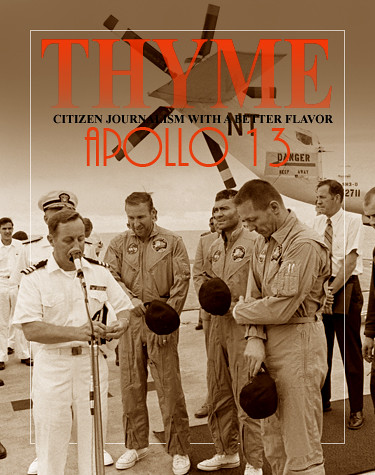
Volume XVIII, Issue VII: Apollo Thirteen
Commander Philip Eldredge Jerauld (at microphone), ship's chaplain for U.S.S. Iwo Jima, offers a prayer of thanks for the safe return of the Apollo 13 crew members soon after they arrived aboard the recovery ship. Standing in the center of the picture, from the left, are astronauts James A. Lovell Jr., Commander; Fred W. Haise Jr., Lunar Module Pilot; and John L. Swigert Jr., Command Module Pilot. The Apollo 13 Command Module "Odyssey" splashed down at 12:07:44 p.m. (CST), April 17, 1970, to conclude safely a perilous space flight. The three astronauts were picked up by helicopter and flown to the U.S.S. Iwo Jima.

The damaged service module of Apollo 13 as photographed by the astronauts. NASA
“Failure is the Best Teacher”
“The greatest teacher, failure is.” – Yoda in The Last Jedi
For a just man falleth seven times, and riseth up again” – Proverbs 24:16a
Thomas Edison invented the microphone, the phonograph, the incandescent light, the storage battery, talking movies, and more than 1000 other things. December 1914 he had worked for 10 years on a storage battery. This had greatly strained his finances. This particular evening spontaneous combustion had broken out in the film room. Within minutes all the packing compounds, celluloid for records and film, and other flammable goods were in flames. Fire companies from eight surrounding towns arrived, but the heat was so intense and the water pressure so low that the attempt to douse the flames was futile. Everything was destroyed. Edison was 67. With all his assets going up in a whoosh (although the damage exceeded two million dollars, the buildings were only insured for $238,000 because they were made of concrete and thought to be fireproof), would his spirit be broken? The inventor’s 24-year old son, Charles, searched frantically for his father. He finally found him, calmly watching the fire, his face glowing in the reflection, his white hair blowing in the wind. “My heart ached for him,” said Charles. “He was 67—no longer a young man—and everything was going up in flames. When he saw me, he shouted, ‘Charles, where’s your mother?’ When I told him I didn’t know, he said, ‘Find her. Bring her here. She will never see anything like this as long as she lives.’” The next morning, Edison looked at the ruins and said, “There is great value in disaster. All our mistakes are burned up. Thank God we can start anew.” Three weeks after the fire, Edison managed to deliver the first phonograph” – Erwin W. Lutzer, Failure, the Backdoor to Success, Moody Press, Chicago, 1975, 1984, p. 17
Edison, you will recall, had worked on the filament for his electric light bulb, famously stating that he had found scores of materials that didn’t work. Finally, his persistence prevailed.
When the United States embarked on the space program that would send the first humans to the moon, it enjoyed an incredible success rate. Mercury and Gemini launched repeatedly and always brought their crews safely home. Some of the near-misses like the early space-walks were forgotten. Then came ‘The Fire.’ As the first moonship, Apollo 1, was going through a routine test on the pad a spark ignited the oxygen atmosphere in the spacecraft. Astronauts Gus Grissom, Ed White and Roger Chaffee perished in seconds! Although NASA wrote the book on safety engineering in many ways, in their haste to fly Apollo they overlooked some wiring issues. “Go Fever” had resulted in three astronauts dying. Many observers look at that disaster as a defining moment for NASA. Nothing was to be taken for granted anymore. “Tough and Competent” became the guidelines for what became essentially a new mission. Apollo would go on to take men to the moon. Apollo 11 and 12 landed there.
The news media actually became bored with spaceflight. Apollo 13 rolled out to minimal press coverage. Fifty years ago astronauts: Jim Lovell, Jack Swigert, and Fred Haise took off to explore the Fra Mauro highlands of the moon. As the craft was on the way to their destination an electrical spark caused an explosion on the system that handled oxygen and power generation. The craft was crippled. Had this explosion occurred on the Apollo 8 mission, the crew would have died. Apollo 8 flew around the moon with no Lunar Module, the separate craft used to land on the moon because the team at Grumman Aircraft was struggling to get the Lunar Module ready to fly. Grumman airplanes had a reputation for always bringing their crews safely home and Tom Kelly, lead engineer of the LM project, was not going to rush the process of assuring that this craft was ready.
Inventing the process as they went along, the astronauts and mission control were able to use Apollo 13’s LM as a ‘lifeboat’ for the stricken star voyagers. They looped around the moon in a free-return trajectory not unlike that described in Jules Verne’s From the Earth to the Moon. They splashed down safely after 5 days in space and the spacecraft was substantially redesigned before the mission of Apollo 14.
In this day and time many of us know the feeling of failure. It is tempting to say that that must be the end of the story; But look at Scripture. Time and time again we see very ordinary people do amazing things empowered and led by the Divine. Last week we looked at the story of Boaz, the Kinsman Redeemer. His mother was a lady named Rahab. If you read the Biblical account of Rahab you will meet a woman who probably felt like a failure. As a practitioner of ‘the oldest profession,’ she would not likely have felt herself a Matriarch of the community. She may have made a number of bad choices in her life – up to the point where she chose the way of the Divine. She helped the nation of Israel in a time of need. In choosing Israel she became a part of Israel. Her child Boaz would marry Ruth. Their son Obed would father Jesse, the father of King David. The moral of the story is that today brings the opportunity for good decision. Good decision, enlightened by the Divine, holds the promise of great success. We must never forget that.
The Public Art Archive
Local Works in National Searchable Archive

Watering Can [click to visit] by Willy Ferguson.

Sunflowers [click to visit] by Madeline Maas and Augusta Christian Educators Studio Students.
While looking for art resources to pass the time during isolation, I discovered the Public Art Archive [click to visit], a searchable database of the nation’s public art. Since I always enjoy seeing public art in my travels, and am always in wonder at the works my cousin Page Jordan finds in her travels around Portland, Oregon, this was a great find. Portland is rich in murals. You can also find a lot of the art in Charlotte, North Carolina’s LYNX stations here. In any case, the site will provide you with many fine works to enjoy across the country. Here are some local works that have been added to the archive.

Crozet Trestle Mural [click to visit] by Bob Kirchman, John Pembroke, Kristina Elaine Greer, Meg West and Western Albemarle High School Students.

Hollyhocks [click to visit] by Bob Kirchman.
The First Passover

Engraving by C. Schönherr
The angel is going through King Pharaoh's land. He is going through it in the night. The angel will go into King Pharaoh's house and make his son to die. He will go into all the people's houses and make their sons to die because they have been so cruel to the Israelites. But the angel will not go into the houses where the Israelites live, to make their sons die. G-d told the Israelites that the angel was coming, and he told them to kill a lamb, and take its blood and sprinkle it over the doors of the houses. And when the angel saw the blood, G-d said, he would not come into the house to hurt them. In the picture we see the blood sprinkled over the door and at each side of it. The angel sees the blood. He will pass over this house and not harm any one in it. We can see the family inside. They are eating the Feast of the Passover.
Illustration from the 1897 Bible Pictures and What They Teach Us
Entry Into Jerusalem
Palm Sunday

Entry into Jerusalem, Hippolyte Flandrin, 1842.
The Stations of the Cross
Bishop Robert Barron
